Analysis of RC Beams under Combined Torsion and Shear Using Optimization Techniques Evaluation of NBR 6118 and AASHTO LRFD Standards
Abstract
:1. Introduction
2. Calculation Procedure to Generate Torsion–Shear Interaction Curves
2.1. Statement of the Problem
2.2. Optimization Procedure
- For a given reference beam, enter the following initial data:
- Geometry of the rectangular cross-section: b and ;
- Mechanical properties for steel reinforcement: , and ;
- Mechanical properties for concrete: ;
- Detailing and amount of transverse and longitudinal steel reinforcement: , , , and . Where = width of the cross-section (m); = height of the cross-section (m); = yielding stress for the longitudinal reinforcement (MPa); = yielding stress for the transverse reinforcement (MPa); = Young’s modulus for steel (MPa); = characteristic concrete compressive strength (MPa); = area of transverse steel reinforcement, considering two legs, to resist the acting shear force (m2); = area of transverse steel reinforcement, considering one leg, to resist the acting torque (m2); = area of one rebar of the longitudinal reinforcement (m2); = longitudinal spacing between stirrups (m); = concrete cover (m).
- Compute the following initial parameters: , , , , , , , , , , , , , , and . Where = width of the stirrups (m); = height of the stirrups (m); = diameter of transverse reinforcement rebar (m); = diameter of longitudinal reinforcement rebar (m); = effective depth of the cross-section (m); = effective thickness of the concrete diagonal strut (m); = distance between the axis of the longitudinal rebar in the corner and the outer face of the cross-section (m); = area of the longitudinal reinforcement in the tensile zone (m2); = area of the longitudinal reinforcement in the compressive zone (m2); = total area of longitudinal reinforcement in the cross-section (m2); = area of the cross-section (m2); = outer perimeter of the cross-section (m); = area enclosed by the center line of stirrups (m2); = perimeter of the centerline of stirrups (m); = area enclosed by the centerline of flow of shear stress (m2); = perimeter of the centerline of flow of shear stress (m).
- Calculate the torques and shear forces, including the maximum and equivalent values for the combined internal forces, according to the standards. As recommended for all numerical computations, variables are normalized to stay roughly in the range (−1, 1). Therefore, forces are scaled using the maximum allowable values according to the specific standard.
- Define the objective function in terms of the parameters involved to calculate the strength for the acting internal forces. This function is defined according to Equation (3).
- Maximize the objective function subject to design constraints, which are derived from limits related to the crushing of concrete struts, yielding of longitudinal reinforcement, and yielding of transverse reinforcement, among others.
Post-Processing
2.3. Constraints from NBR 6118
- The acting shear force in the cross-section, , must not exceed the design shear strength corresponding to the crushing of the concrete diagonal struts, , as follows [32]:
- The acting shear force in the cross-section, , must not exceed the design shear strength corresponding to the failure due to diagonal tension, , as follows [32]:where for simple bending and for bending combined with tensile axial force (with the neutral axis located in the cross-section). is defined as when , and when (linear interpolation can be used for intermediate values). is defined as follows [32]:where = shear strength contributed by the concrete for simple bending and for bending combined with tensile axial force (with the neutral axis located in the cross-section); = inferior characteristic tensile strength of concrete; = shear strength contributed by the transverse reinforcement; = area of transverse reinforcement; = design yielding stress of the transverse reinforcement.
- The acting torque in the cross-section, , must not exceed the limit corresponding to the strength of the concrete diagonal struts, [32], as follows:
- The acting torque in the cross-section, , must not exceed the limit corresponding to the strength of the stirrups, [32], as follows:where represents the area of one leg of the transverse reinforcement build with stirrups normal to the longitudinal axis (90°).
- The acting torque in the cross-section, , must not exceed the limit corresponding to the strength of the longitudinal reinforcement, [32], as follows:
2.4. General Formulation for the Optimization Problem According to NBR 6118
2.5. Constraints from AASHTO LRFD
- = Nominal resistance (strength) is defined as the resistance of a component or connection to force effects, as indicated by the dimensions specified in the contract documents and by permissible stresses, deformations, or specified strength of materials;
- = Factored (design) resistance is defined as the nominal resistance multiplied by a resistance factor, i.e., . The resistance factor, , is defined to be a statistically-based multiplier applied to nominal resistance accounting primarily for variability of material properties, structural dimensions and workmanship, and uncertainty in the prediction of resistance, but also related to the statistics of the loads through the calibration process;
- = Ultimate resistance (strength) is the limit related to the strength and stability during the design life.
2.6. General Formulation for the Optimization Problem According to AASHTO LRFD
3. Results and Discussion
3.1. Combined Action—Softened Truss Model
3.2. Results for Reference RC Beams from Series 1 and 2
3.3. Discussion of the Results
4. Conclusions
- The proposed calculation procedure based on optimization techniques allows researchers to easily compute the torsion–shear interaction curves of RC cross-sections based on design standards. The proposed calculation procedure is discussed as part of this paper.
- Model I with an angle for the concrete struts = 45°, according to NBR 6118 standard to compute the shear strength, was found to be very conservative for RC members under combined torsion and shear;
- Model II with an angle for the concrete struts = 30°, according to NBR 6118 standard to compute the shear strength, was found to be reliable for RC members under combined torsion and shear;
- Good results were also found when considering a variable angle for the concrete struts according to the NBR 6118 standard. For this model, the proposed optimization calculation procedure appeared to be very suitable to calculate the resistance of the RC cross-section for the combined acting forces. It allows us to easily solve the difficulty in determining some key parameters involved in the calculation procedure, such as the equivalent wall thickness, , and the distance from the middle plan of the wall to the outer face of the cross-section, . This was confirmed during the optimization calculation procedure, since it was observed that is not always equal to half of the wall thickness (Table 7);
- The AASHTO LRFD standard is simpler for the analysis of RC cross-sections under combined torsion and shear, although considered more complete, when compared with the NBR 6118 standard. This is because AASHTO LRFD considers the influence off several factors through the longitudinal deformation, . The results obtained according to this standard were found to be consistent with the experimental results;
- The CA-STM model was also found to be consistent in computing the resistance of RC cross-sections under combined torsion and shear. It was also found that, with this model, the theoretical value for the torsional strength seems to become slightly conservative as the acting shear strength increases. However, CA-STM is somewhat of a complex model to be suitable for design work. The optimization calculation procedure proposed in this study is more suitable for the practice.
Author Contributions
Funding
Institutional Review Board Statement
Informed Consent Statement
Data Availability Statement
Conflicts of Interest
Appendix A

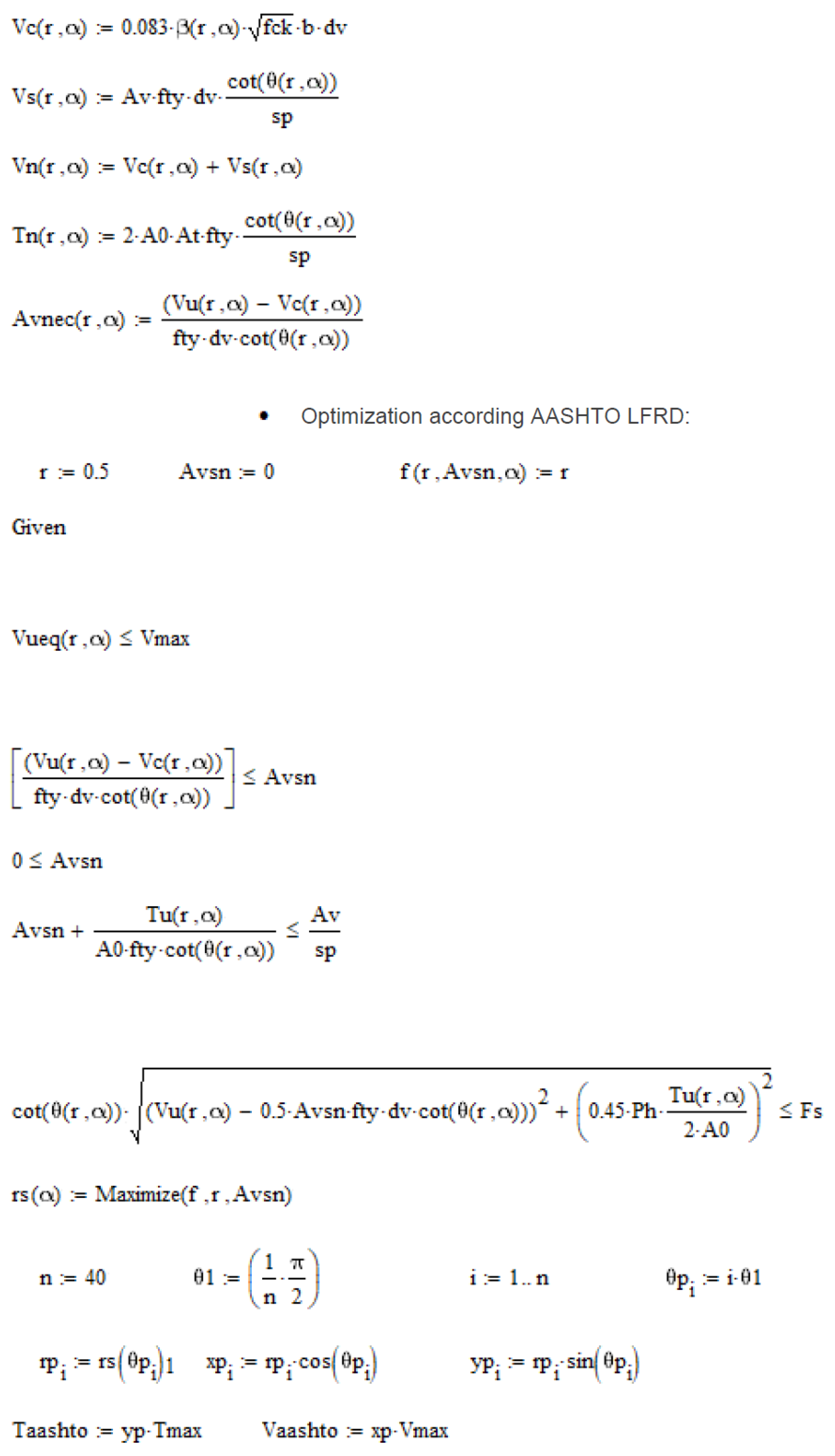
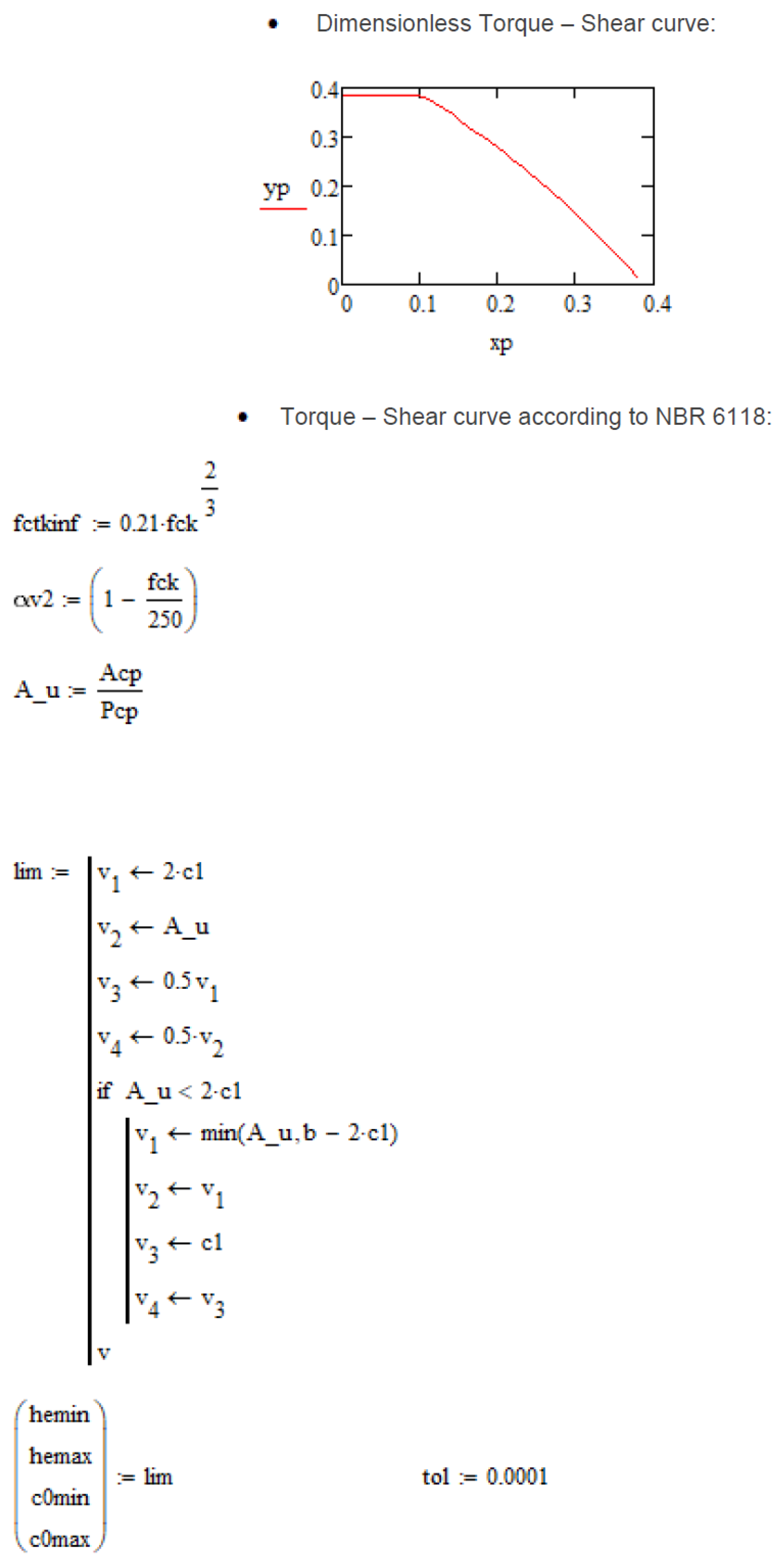
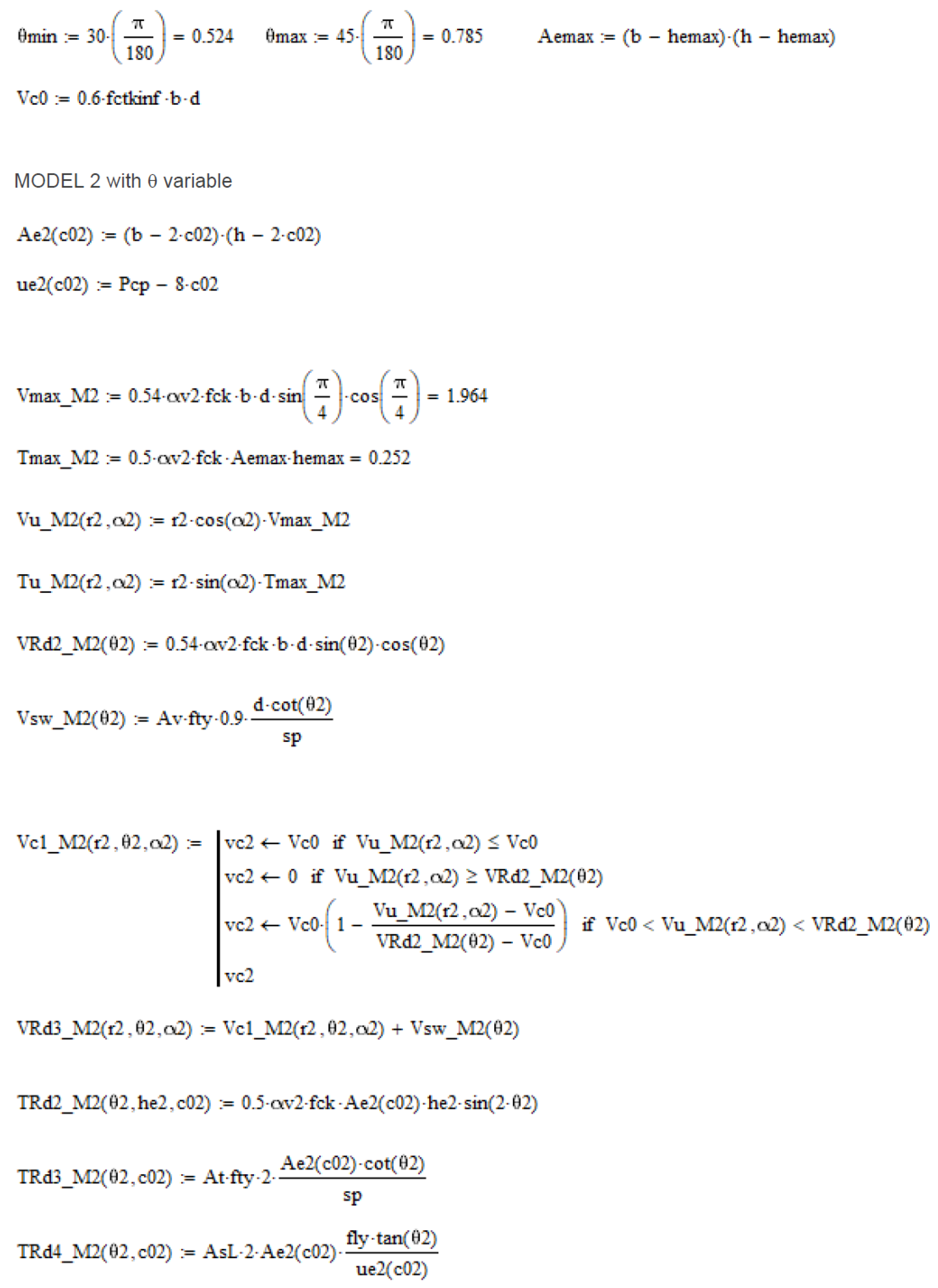


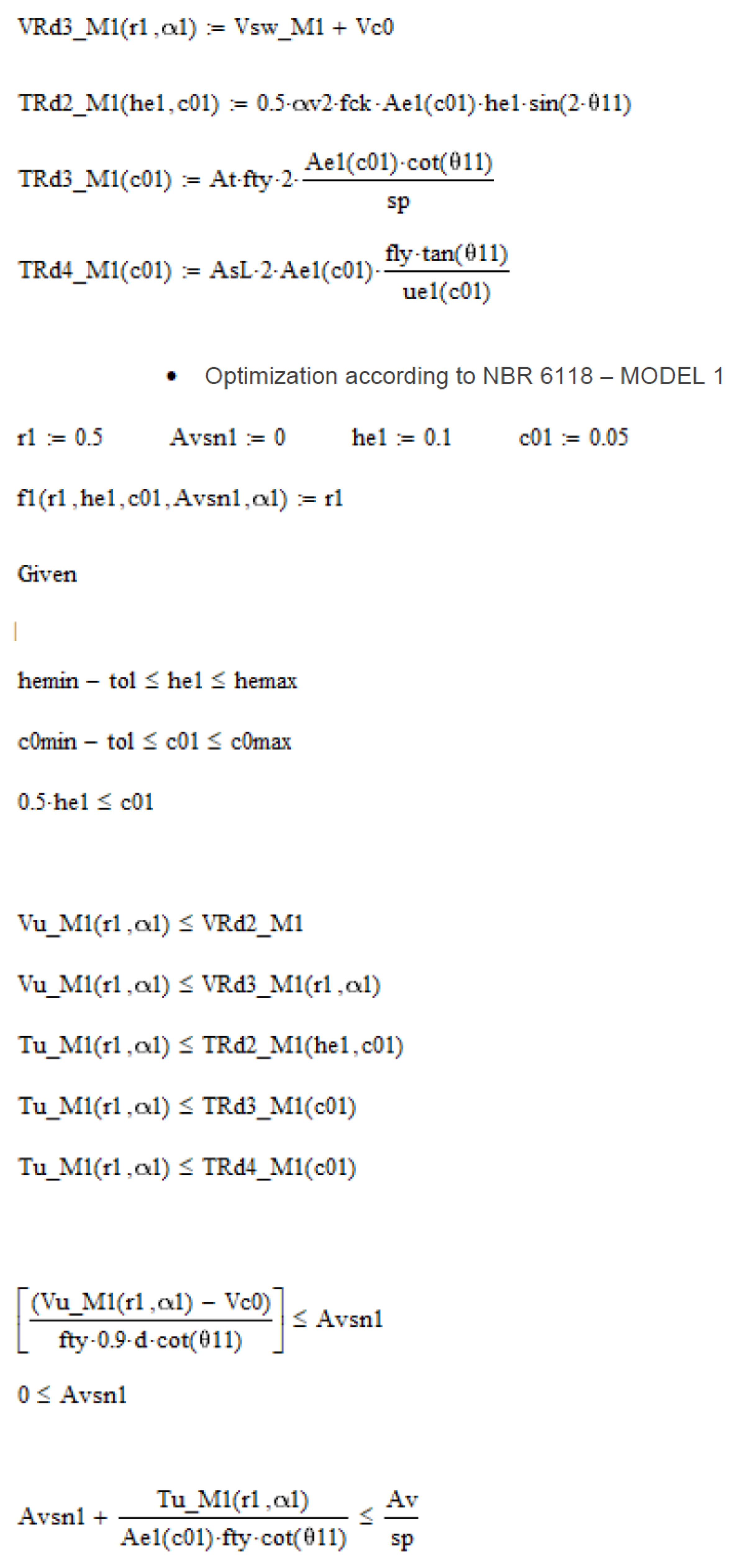
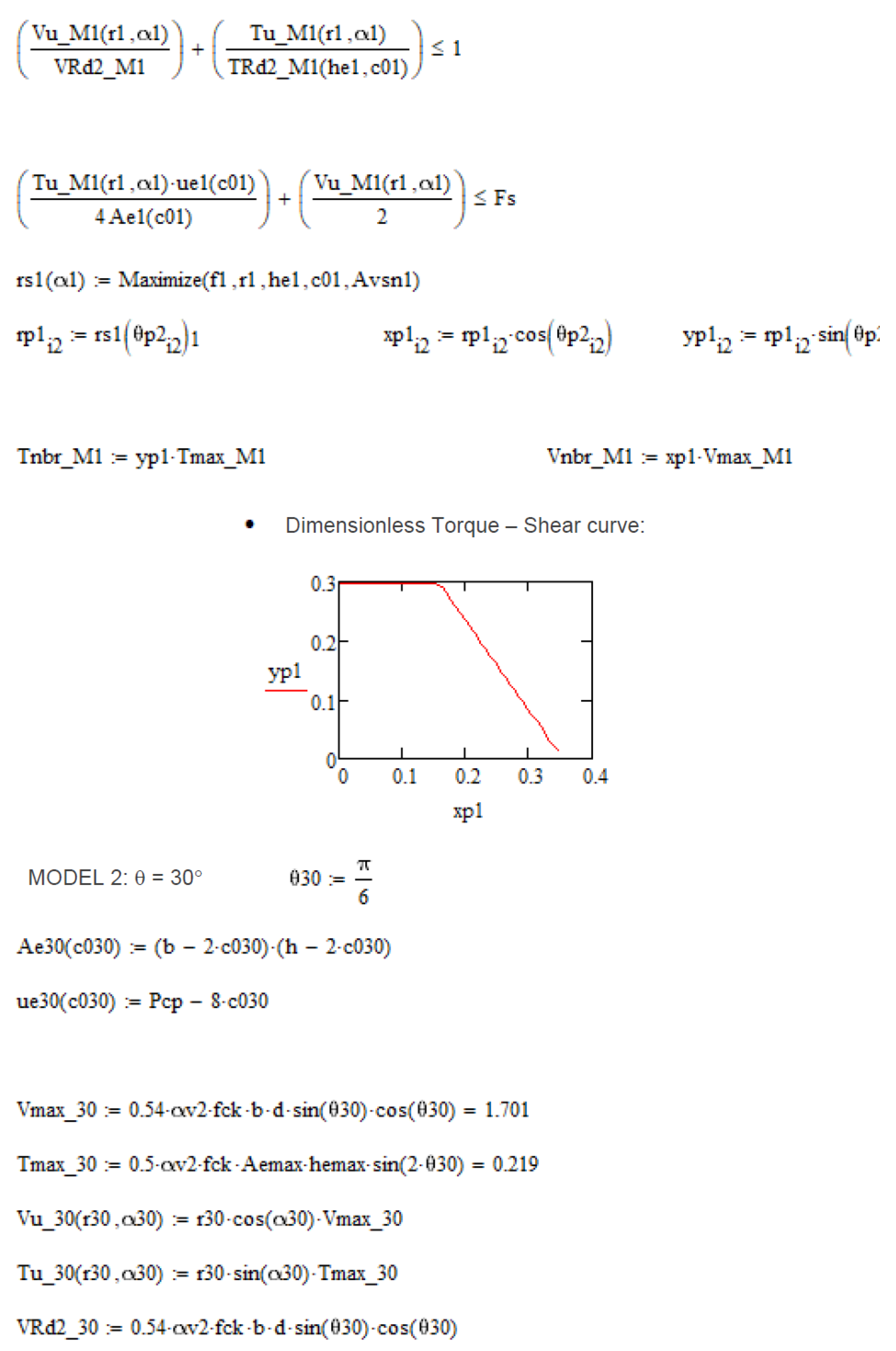
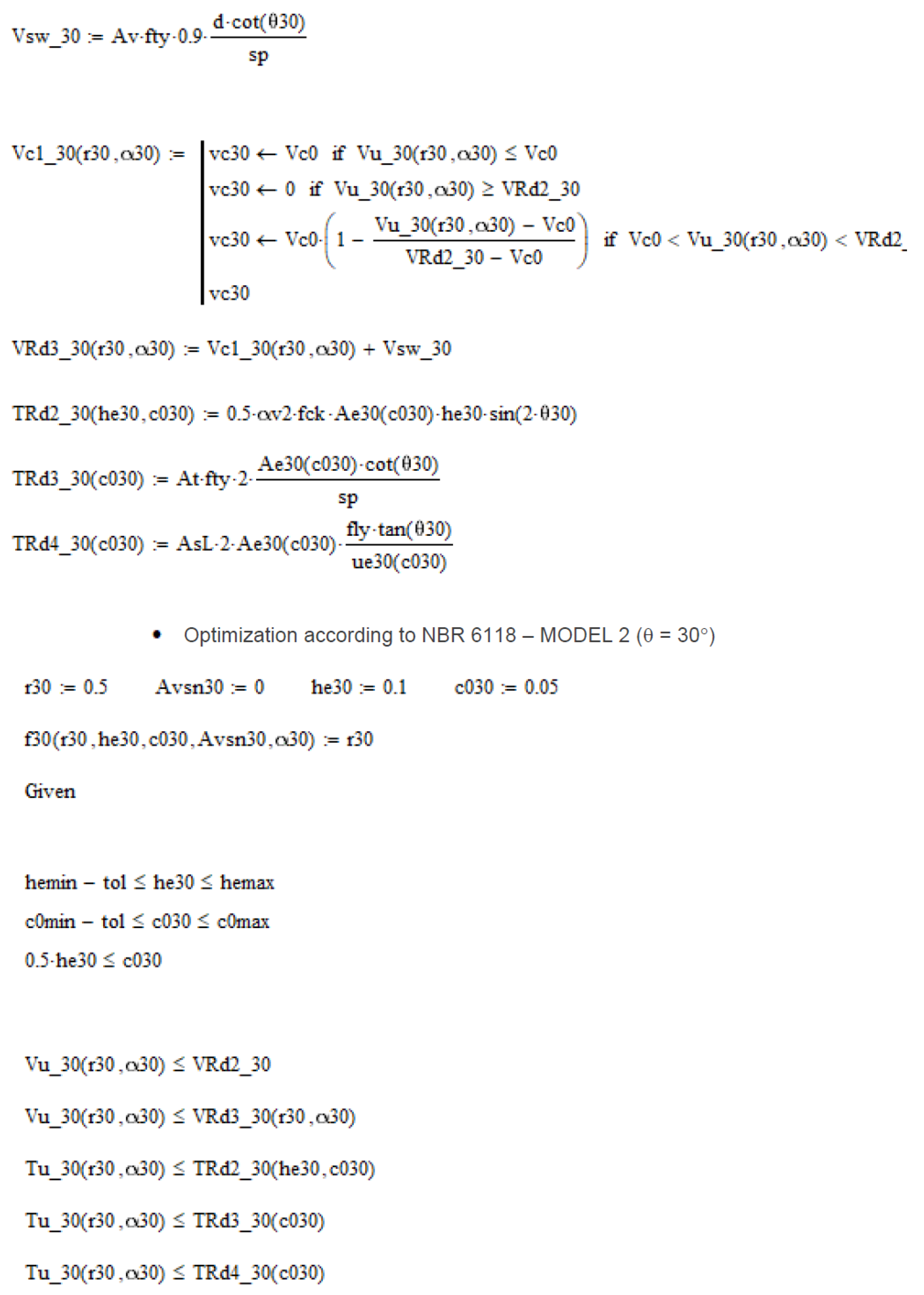
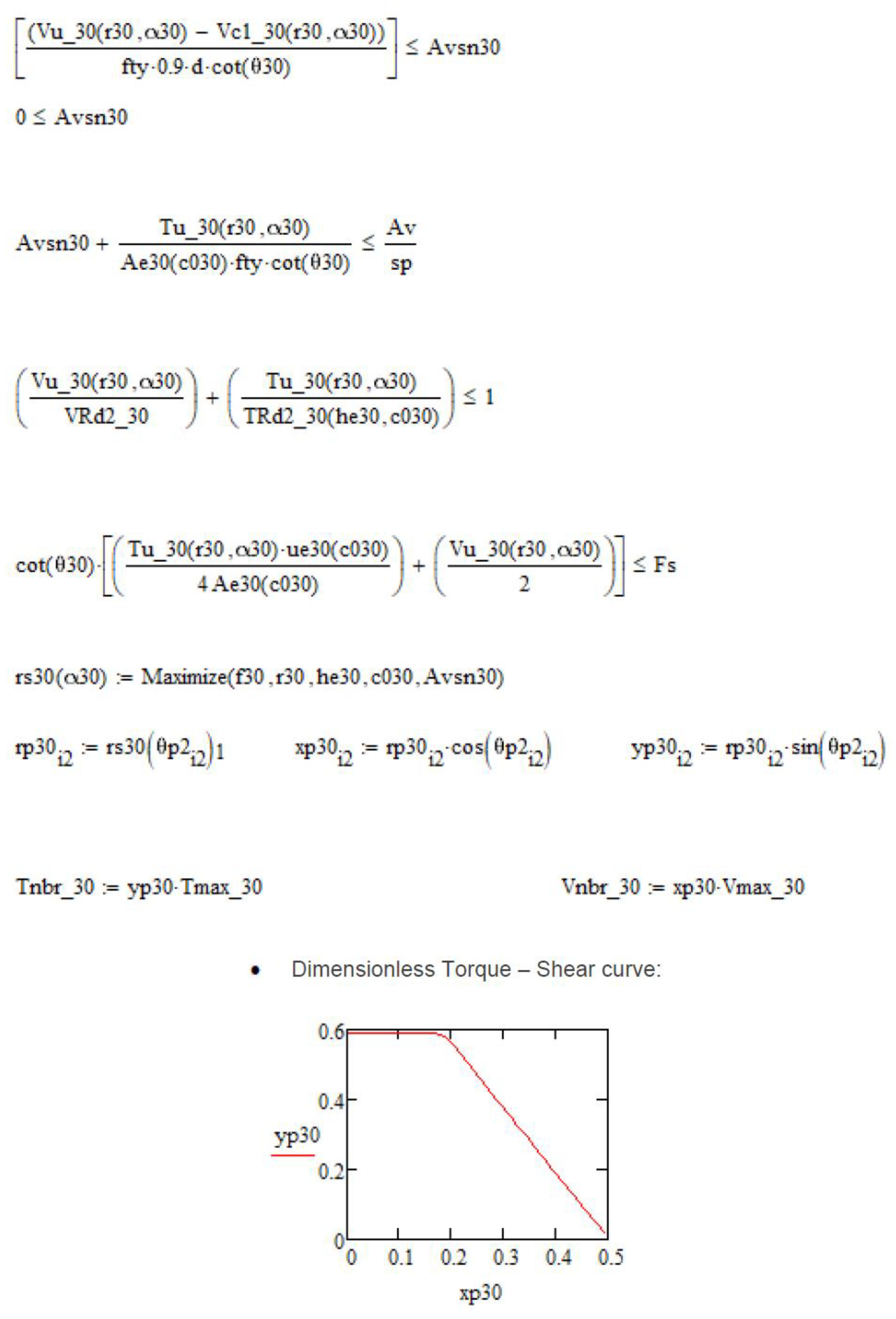
Appendix B

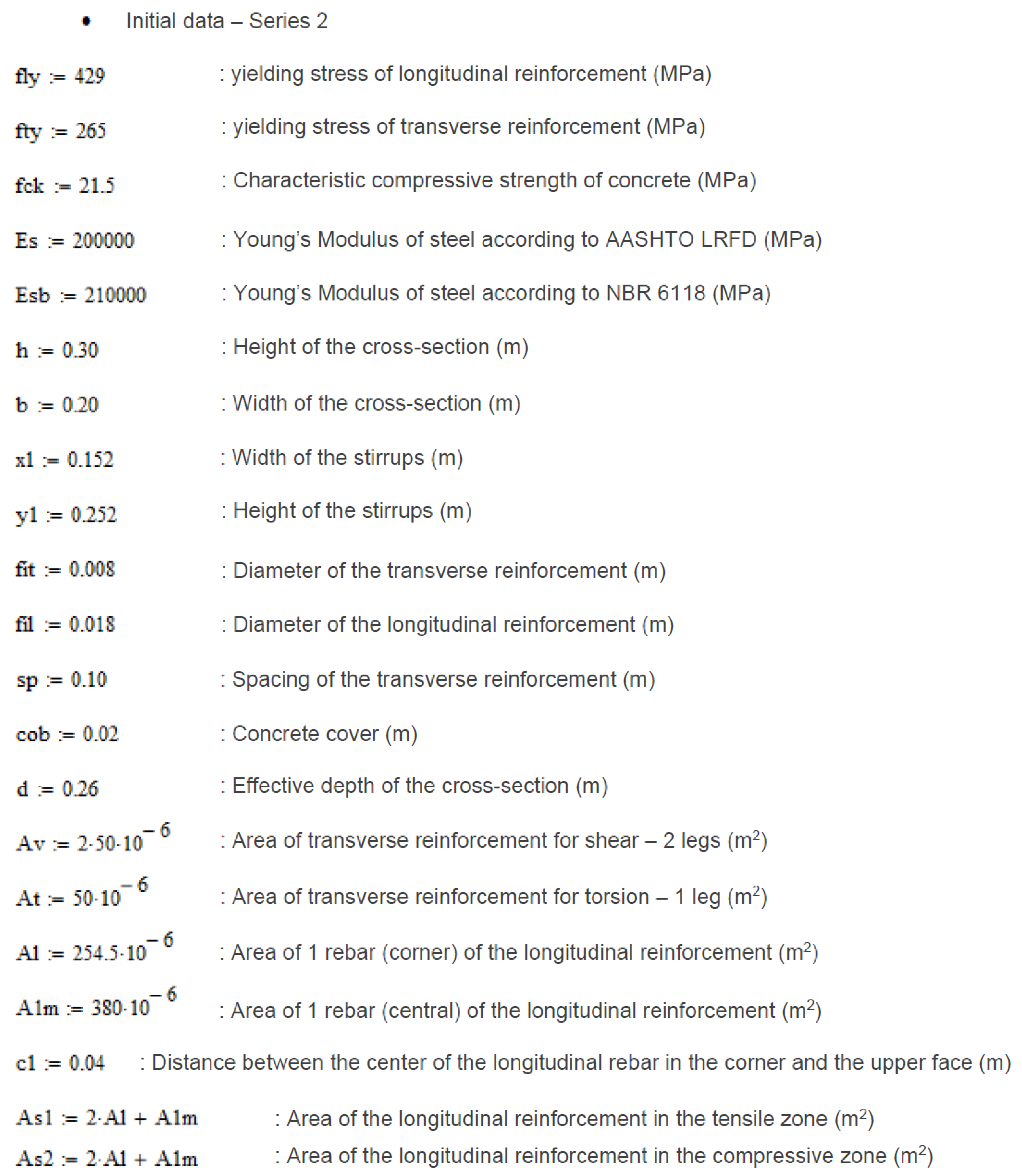
References
- Badawy, H.E.I.; McMullen, A.E.; Jordaan, I.J. Experimental investigation of the collapse of reinforced concrete curved beams. Mag. Concr. Res. 1977, 29, 59–69. [Google Scholar] [CrossRef]
- Hsu, T.T.C. Torsion of structural concrete—Behaviour of reinforced concrete rectangular members. In Torsion of Structural Concrete; SP-18; American Concrete Institute: Farmington Hills, MI, USA, 1968; pp. 261–306. [Google Scholar]
- McMullen, A.E.; Warwaruk, J. Concrete beams in bending, torsion and shear. J. Struct. Div. 1970, 96, 885–903. [Google Scholar] [CrossRef]
- Elfgren, L.; Karlsson, I.; Losberg, A. Torsion-bending-shear interaction for concrete beams. J. Struct. Div. 1974, 100, 1657–1676. [Google Scholar] [CrossRef]
- Rausch, E. Berechnung des Eisenbetons gegen Verdrehung (Design of Reinforced Concrete in torsion). Ph.D. Thesis, Technische Hochschule, Berlin, Germany, 1929; p. 53. (In German). [Google Scholar]
- Mitchell, D.; Collins, M.P. Diagonal compression field theory—A rational model for structural concrete in pure torsion. ACI J. 1974, 71, 396–408. [Google Scholar]
- Hsu, T.T.C.; Mo, Y.L. Softening of concrete in torsional members—Theory and tests. J. Am. Concr. Inst. 1985, 82, 290–303. [Google Scholar]
- Jeng, C.-H.; Hsu, T.T.C. A softened membrane model for torsion in reinforced concrete members. Eng. Struct. 2009, 31, 1944–1954. [Google Scholar] [CrossRef]
- Bernardo, L.F.A.; Andrade, J.M.A.; Nunes, N.C.G. Generalized softened variable angle truss-model for reinforcement concrete beams under torsion. Mater. Struct. 2015, 48, 2169–2193. [Google Scholar] [CrossRef]
- Bernardo, L.F.A.; Andrade, J.M.A. A unified softened truss model for RC and PC concrete beams under torsion. J. Build. Eng. 2020, 32, 101467. [Google Scholar] [CrossRef]
- Lampert, P.; Thürlimann, B. Ultimate strength and design of reinforced concrete beams in torsion and bending. In Ultimate Strength and Design of Reinforced Concrete Beams in Torsion and Bending/Résistance et dimensionnement des poutres en béton armé soumises à la torsion et à la flexion/Bruchwiderstand und Bemessung von Stahlbetonbalken unter Torsion und Biegung; Institut für Baustatik und Konstruktion, Birkhäuser: Basel, Switzerland, 1972; Volume 42, pp. 107–131. [Google Scholar]
- Rahal, K.N.; Collins, M.P. Combined torsion and bending in reinforced and prestressed concrete beams. ACI Struct. J. 2003, 100, 157–165. [Google Scholar]
- Rahal, K.N.; Collins, M.P. Analysis of sections subjected to combined shear and torsion—A theoretical model. ACI Struct. J. 1995, 92, 459–469. [Google Scholar]
- Fouad, E.; Ghoneim, M.; Issa, M.; Shaheen, H. Combined shear and torsion in reinforced normal and high-strength concrete beams (1): Experimental study. J. Eng. Appl. Sci. 2000, 47, 1059–1078. [Google Scholar]
- Rahal, K.N. A unified approach to shear and torsion in reinforced concrete. Struct. Eng. Mech. 2021, 77, 691–703. [Google Scholar]
- Kothamuthyala, S.R.; Thammishetti, N.; Prakash, S.S.; Vyasarayani, C.P. Optimization-based improved softened membrane model for rectangular reinforced concrete members under combined shear and torsion. J. Struct. Eng. 2019, 145, 04018259. [Google Scholar] [CrossRef]
- Cocchi, G.M.; Volpi, M. Inelastic analysis of reinforced concrete beams subjected to combined torsion, flexural and axial loads. Comput. Struct. 1996, 61, 479–494. [Google Scholar] [CrossRef]
- Bernardo, L.F.A.; Taborda, C.S.B.; Andrade, J.M.A. Ultimate torsional behaviour of axially restrained RC beams. Comput. Concr. 2015, 16, 67–97. [Google Scholar] [CrossRef]
- Ganganagoudar, A.; Mondal, T.G.; Prakash, S.S. Improved softened membrane model for reinforced concrete circular bridge columns under torsion. J. Bridge Eng. 2016, 21, 04016037. [Google Scholar] [CrossRef]
- Rabbat, B.G.; Collins, M.P. A variable angle space truss model for structural concrete members subjected to complex loading. In Douglas McHenriy International Symposium on Concrete and Concrete Structures; ACE SP-55; American Concrete Institute: Farmington Hills, MI, USA, 1978; pp. 547–587. [Google Scholar]
- Greene, G.G.; Belarbi, A. Model for reinforced concrete members under torsion, bending, and shear. I: Theory. J. Eng. Mech. 2009, 135, 961–969. [Google Scholar] [CrossRef]
- Valipour, H.R.; Foster, S.J. Nonlinear reinforced concrete frame element with torsion. Eng. Struct. 2010, 32, 988–1002. [Google Scholar] [CrossRef]
- Silva, J.; Horowitz, B.; Bernardo, L. Efficient analysis of beam sections using softened truss model. ACI Struct. J. 2017, 114, 765–774. [Google Scholar] [CrossRef] [Green Version]
- Ju, H.; Lee, D.; Zhang, W.; Wang, L. Torsional strength model of reinforced concrete members subjected to combined loads. Comput. Concr. 2022, 29, 285–301. [Google Scholar]
- Alnauimi, A.S.; Bhatt, P. Direct design of hollow reinforced concrete beams. Part I: Design procedure. Struct. Concr. 2004, 5, 139–146. [Google Scholar] [CrossRef]
- Bairan Garcia, J.M.; Mari Bernat, A.R. Shear-bending-torsion interaction in structural concrete members: A nonlinear coupled sectional approach. Arch. Comput. Methods Eng. 2007, 14, 249–278. [Google Scholar] [CrossRef]
- Karayannis, C.G. Smeared crack analysis for plain concrete in torsion. J. Struct. Eng. 2000, 126, 638–645. [Google Scholar] [CrossRef]
- Karayannis, C.G.; Chalioris, C.E. Experimental validation of smeared analysis for plain concrete in torsion. J. Struct. Eng. 2000, 126, 646–653. [Google Scholar] [CrossRef]
- Deifalla, A.; Salem, N.M. A Machine learning model for torsion strength of externally bonded FRP-reinforced concrete beams. Polymers 2022, 14, 1824. [Google Scholar] [CrossRef]
- Lyu, Z.; Yu, Y.; Samali, B.; Rashidi, M.; Mohammadi, M.; Nguyen, T.N.; Nguyen, A. Cross-validation for prediction of tor-sional strength of reinforced concrete beam. Materials 2022, 15, 1477. [Google Scholar] [CrossRef]
- American Association of State Highway and Transportation Officials (AASHTO). LRFD: Bridge Design, Specifications; AASHTO: Washington, DC, USA, 2014. [Google Scholar]
- Associação Brasileira de Normas Técnicas (ABNT). NBR 6118, Projeto de Estruturas de Concreto; ABNT: Rio de Janeiro, Brazil, 2014. [Google Scholar]
- Rahal, K.N.; Collins, M.P. Effect of the thickness of concrete cover on the shear-torsion interaction—An experimental investigation. ACI Struct. J. 1995, 92, 334–342. [Google Scholar]
- Halim, A.H.; Rasheed, H.A.; Esmaeily, A. Software for AASHTO LRFD Combined Shear and Torsion Computations Using Modified Compression Field Theory and 3D Truss Analogy; Report; Kansas Departament of Transportation, Kansas State University: Manhattan, KS, USA, 2011. [Google Scholar]
- Rahal, K.N.; Collins, M.P. Experimental evaluation of ACI and AASHTO-LRFD design provisions for combined shear and torsion. ACI Struct. J. 2003, 100, 277–281. [Google Scholar]
- Klus, P.J. Ultimate strength of reinforced concrete beams in combined torsion and shear. ACI Struct. J. 1968, 65, 210–215. [Google Scholar]
- PTC. Mathcad 14: User’s Guide; Parametric Technology Corporation: Needham, MA, USA, 2011. [Google Scholar]
- Bentz, E.C.; Collins, M.P. Development of the 2004 Canadian standards association (CSA) A23.3 shear provisions for reinforced concrete. Can. J. Civ. Eng. 2006, 33, 521–534. [Google Scholar] [CrossRef]
- Silva, J.R.B. Efficient Procedure for the Analysis of Reinforced Concrete Cross-Sections Using the Softened Truss Model. Master’s Thesis, Federal University of Pernambuco, Recife, Brazil, 2016. (In Portuguese). [Google Scholar]
- Bernardo, L.F.A.; Teixeira, M.M. Refined softened-truss model with efficient solution procedure for reinforced concrete members under torsion combined with bending. Structures 2020, 26, 651–669. [Google Scholar] [CrossRef]



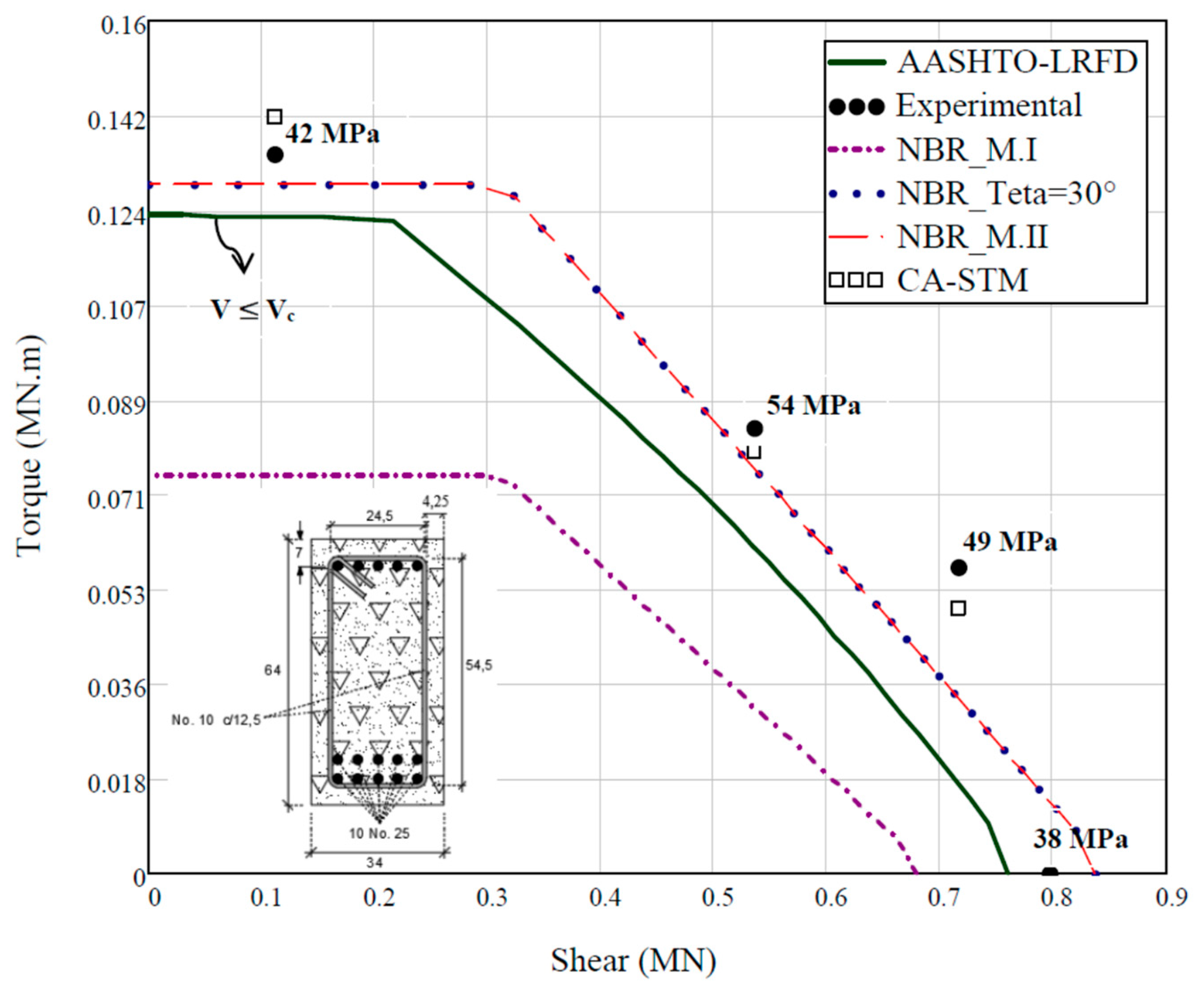

| Experimental | NBR 6118 M-I | NBR 6118 = 30 ° | NBR 6118 M-II | AASHTO LRFD | CA-STM | |||||||
|---|---|---|---|---|---|---|---|---|---|---|---|---|
| Beam | V (MN) | T (MN.m) | V (MN) | T (MN.m) | V (MN) | T (MN.m) | V (MN) | T (MN.m) | V (MN) | T (MN.m) | V (MN) | T (MN.m) |
| RC2-1 | 0.535 | 0.083 | 0.387 | 0.06 | 0.518 | 0.081 | 0.518 | 0.081 | 0.476 | 0.074 | 0.536 | 0.08 |
| RC2-2 | 0.796 | 0 | 0.678 | 0 | 0.837 | 0 | 0.837 | 0 | 0.76 | 0 | 0.796 | 0 |
| RC2-3 | 0.111 | 0.135 | 0.062 | 0.075 | 0.108 | 0.129 | 0.108 | 0.129 | 0.103 | 0.123 | 0.112 | 0.142 |
| RC2-4 | 0.715 | 0.058 | 0.494 | 0.039 | 0.64 | 0.051 | 0.64 | 0.051 | 0.595 | 0.048 | 0.716 | 0.05 |
| Beam | NBR 6118 M-I | NBR 6118 = 30° | NBR 6118 M-II | AASHTO LRFD | CA-STM |
|---|---|---|---|---|---|
| RC2-1 | 27.7 | 2.4 | 2.4 | 10.8 | 3.6 |
| RC2-2 | - | - | - | - | - |
| RC2-3 | 44.4 | 4.4 | 4.4 | 8.9 | −5.2 |
| RC2-4 | 32.8 | 12.1 | 12.1 | 17.2 | 13.8 |
| Beam | NBR 6118 M-I | NBR 6118 = 30° | NBR 6118 M-II | AASHTO LRFD | CA-STM |
|---|---|---|---|---|---|
| RC2-1 | 27.7 | 3.2 | 3.2 | 11 | −0.2 |
| RC2-2 | 14.8 | −5.2 | −5.2 | 4.5 | 0 |
| RC2-3 | 44.1 | 2.7 | 2.7 | 7.2 | −0.9 |
| RC2-4 | 30.9 | 10.5 | 10.5 | 16.8 | −0.1 |
| Experimental | NBR 6118 M-I | NBR 6118 θ = 30° | NBR 6118 M-II | AASHTO LRFD | CA-STM | |||||||
|---|---|---|---|---|---|---|---|---|---|---|---|---|
| Beam | V (MN) | T (MN.m) | V (MN) | T (MN.m) | V (MN) | T (MN.m) | V (MN) | T (MN.m) | V (MN) | T (MN.m) | V (MN) | T (MN.m) |
| 1 | 0 | 0.0142 | 0 | 0.0071 | 0 | 0.0121 | 0 | 0.0121 | 0 | 0.0138 | 0 | 0.0149 |
| 2 | 0.03 | 0.0125 | 0.018 | 0.0071 | 0.03 | 0.0119 | 0.03 | 0.012 | 0.035 | 0.0138 | 0.031 | 0.0131 |
| 3 | 0.063 | 0.0115 | 0.039 | 0.0071 | 0.057 | 0.0104 | 0.059 | 0.0106 | 0.067 | 0.012 | - | - |
| 4 | 0.093 | 0.0088 | 0.062 | 0.0058 | 0.082 | 0.0077 | 0.082 | 0.0077 | 0.094 | 0.0088 | 0.094 | 0.0073 |
| 5 | 0.101 | 0.0073 | 0.07 | 0.005 | 0.091 | 0.0065 | 0.091 | 0.0065 | 0.104 | 0.0075 | 0.101 | 0.0062 |
| 6 | 0.118 | 0.0058 | 0.079 | 0.0038 | 0.101 | 0.005 | 0.101 | 0.005 | 0.116 | 0.0057 | 0.118 | 0.0047 |
| 7 | 0.132 | 0.0033 | 0.093 | 0.0023 | 0.116 | 0.0029 | 0.116 | 0.0029 | 0.132 | 0.0033 | - | - |
| 8 | 0.157 | 0 | 0.11 | 0 | 0.134 | 0 | 0.134 | 0 | 0.149 | 0 | - | - |
| Beam | NBR 6118 M-I | NBR 6118 = 30° | NBR 6118 M-II | AASHTO LRFD | CA-STM |
|---|---|---|---|---|---|
| 1 | 50 | 14.8 | 14.8 | 2.8 | −4.9 |
| 2 | 43.2 | 4.8 | 4 | −10.4 | −4.8 |
| 3 | 38.3 | 9.6 | 7.8 | −4.3 | - |
| 4 | 34.1 | 12.5 | 12.5 | 0 | 17.0 |
| 5 | 31.5 | 11 | 11 | −2.7 | 15.1 |
| 6 | 34.5 | 13.8 | 13.8 | 1.7 | 19 |
| 7 | 30.3 | 12.1 | 12.1 | 0 | - |
| 8 | - | - | - | - | - |
| Beam | NBR 6118 M-I | NBR 6118 = 30° | NBR 6118 M-II | AASHTO LRFD | CA-STM |
|---|---|---|---|---|---|
| 1 | - | - | - | - | - |
| 2 | 40 | 0 | 0 | −16.7 | −3.3 |
| 3 | 38.1 | 9.5 | 6.3 | −6.3 | - |
| 4 | 33.3 | 11.8 | 11.8 | −1.1 | −1.1 |
| 5 | 30.7 | 9.9 | 9.9 | −3 | 0 |
| 6 | 33.1 | 14.4 | 14.4 | 1.7 | 0 |
| 7 | 29.5 | 12.1 | 12.1 | 0 | - |
| 8 | 29.9 | 14.6 | 14.6 | 5.1 | - |
| NBR 6118 θ (°) | NBR 6118 (m) | NBR 6118 (m) | AASHTO LRFD (°) | |
|---|---|---|---|---|
| Series 1 | 30 | 0.111 | 0.07 | 34–35 |
| Series 2 | 30–32 | 0.06 | 0.04 | 32–33 |
Publisher’s Note: MDPI stays neutral with regard to jurisdictional claims in published maps and institutional affiliations. |
© 2022 by the authors. Licensee MDPI, Basel, Switzerland. This article is an open access article distributed under the terms and conditions of the Creative Commons Attribution (CC BY) license (https://creativecommons.org/licenses/by/4.0/).
Share and Cite
Obel, W.; Horowitz, B.; Bernardo, L.F.A. Analysis of RC Beams under Combined Torsion and Shear Using Optimization Techniques Evaluation of NBR 6118 and AASHTO LRFD Standards. J. Compos. Sci. 2022, 6, 175. https://doi.org/10.3390/jcs6060175
Obel W, Horowitz B, Bernardo LFA. Analysis of RC Beams under Combined Torsion and Shear Using Optimization Techniques Evaluation of NBR 6118 and AASHTO LRFD Standards. Journal of Composites Science. 2022; 6(6):175. https://doi.org/10.3390/jcs6060175
Chicago/Turabian StyleObel, William, Bernardo Horowitz, and Luís F. A. Bernardo. 2022. "Analysis of RC Beams under Combined Torsion and Shear Using Optimization Techniques Evaluation of NBR 6118 and AASHTO LRFD Standards" Journal of Composites Science 6, no. 6: 175. https://doi.org/10.3390/jcs6060175






